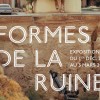Group Show | Forms of the Ruin
The exhibition Forms of the Ruin has its origins in the book by art historian and archaeologist Alain Schnapp, Une histoire universelle des ruines. Des origines aux Lumières, published in 2020 by Éditions du Seuil, of which it is a variation. The aim of the exhibition is to make this history visible, from a global and comparative perspective, from prehistory to the contemporary period.
Why are some works considered to be memorials while others arouse no interest at all until they are rediscovered ? The Greeks looked at the ruins of Egypt or the remains of the palaces of Assyria with unparalleled enthusiasm. The Romans were mad for about Greek works of art and flocked to the sanctuaries to admire them. The clerics of the Middle Ages regarded Roman remains with both admiration and concern. During the Renaissance, curiosity about the Greco-Roman world and the civilisations of America took hold. During the Enlightenment, this interest spread TO include Asia, Africa and Oceania. This Western scenario differs from that of China, Japan and the Arab-Muslim world, which developed their own uses of ruins.
Drawing on a selection of over 300 works, this exhibition is designed as a journey through ruins, in an ongoing dialogue between civilisations and is centered around four themes: memory and oblivion, the tension between nature and culture, the link between the material and the immaterial, and the confrontation between the present and the future. Its ambition is to question societies through history and at the same time to confront the research of contemporary artists in their desire to interpret the ruins of our industrial societies and imagine their future.

